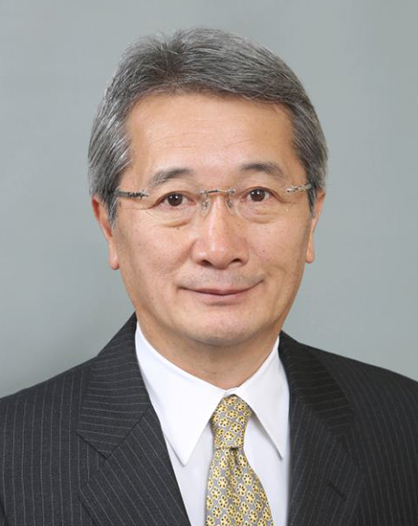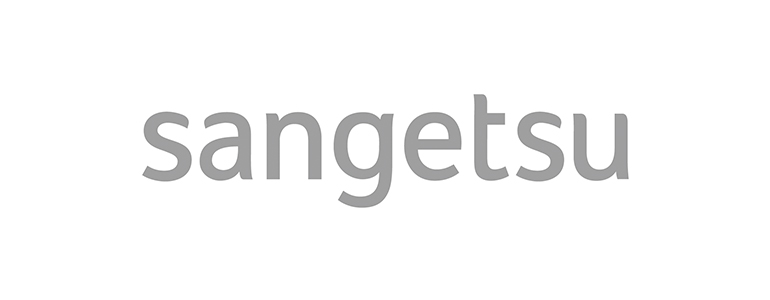| Sangetsu Corporation (8130) |
|
||||||||
Company |
Sangetsu Corporation |
||
Code No. |
8130 |
||
Exchange |
First Section, Tokyo and Nagoya Stock Exchanges |
||
Industry |
Wholesale (Commerce) |
||
President |
Shousuke Yasuda |
||
HQ Address |
1-4-1 Habashita, Nishi-ku, Nagoya-shi |
||
Year-end |
March end |
||
URL |
|||
* Stock price as of closing on December 11, 2017. Number of shares issued at the end of the most recent quarter excluding treasury shares.
ROE and BPS are based on the previous year. |
||||||||||||||||||||||||
|
|
* DPS of March 2013 included commemorative dividend of ¥3.
* Estimates are those of the Company. 2 for 1 stock splits were conducted in April 1, 2015. * From the current fiscal year, the definition for net income has been changed to net income attributable to parent company shareholders (Abbreviated as parent net income). |
| Key Points |
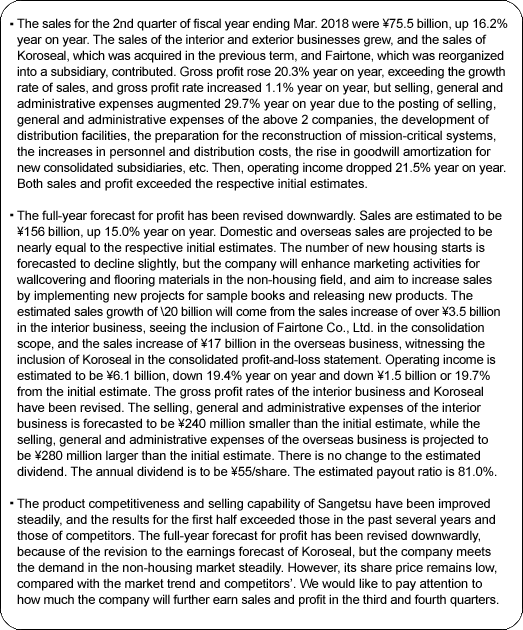 |
| Company Overview |
|
The Sangetsu Group is comprised of six companies including Sangetsu (Shanghai) Corporation, the company responsible for business in China, "Koroseal Interior Products Holdings, Inc.", the United States company conducting sales of wallcovering materials for non-residential applications, Fairtone Co., Ltd., that seeks to grow orders on the back of increases in installation capabilities, Sungreen Co., Ltd., a dedicated distributor of exterior products, and Yamada Shomei Lighting Co., Ltd., a planner, designer, manufacturer and distributor of lighting equipment, and "Sangetsu Vosne Corporation", specialized in curtain fabrics <Corporate History>
Sangetsu was founded in 1849 under the original name of "Sangetsudo" to sell various traditional Japanese interior decorating products including scrolls, wall scrolls, folding screens, sliding doors, partitions, and other products made of cloth and paper. Sangetsu Corporation was incorporated in 1953 by the founding family. From the latter half of the 1970s onwards, the business was expanded into Tokyo, Fukuoka, Osaka and other parts of Japan. In 1980, Sangetsu was listed on the Second Section of the Nagoya Stock Exchange, and later in 1996 its shares were also listed on the First Section of the Tokyo Stock Exchange. Currently, Sangetsu is expanding its operations into overseas markets and has established itself as the largest total interior decorating product provider within Japan, with a widely recognized brand of interior products.Shosuke Yasuda was appointed as the first President who is not from the founding family of Sangetsu in April 2014. He will direct the Company during its third stage of growth entitled "Our Third Founding Phase," following on the heels of the original first phase of founding and the second phase when the company became a publicly listed corporation. <Corporate Philosophy>
Sangetsu established a new corporate philosophy including a new brand philosophy in April 2016 that will enable it to take on the challenge of implementing reforms necessary to take it to its next stage of growth.A new "brand philosophy" has been added to the "corporate creed," "corporate mission," and "Three Principles of Sangetsu" to create an expanded corporate philosophy. <Corporate Creed> Integrity <Corporate Mission> To contribute to society through interior design and strive to create daily culture of enrichment <Three Principles of Sangetsu> Creative Designs, High Reliable Quality, Fair Price <Brand Philosophy> Sangetsu endeavors to share the joy of creating new value through interior business with all of its stakeholders. <Market Environment>
The market environment for the main wallcovering and flooring products is strongly influenced by trends in the Japanese construction market. Declines in new housing start arising from declining population and changing family structures within Japan, and deflationary trends have depressed sales of the interior products market as shown in the graph below.
◎ Overview 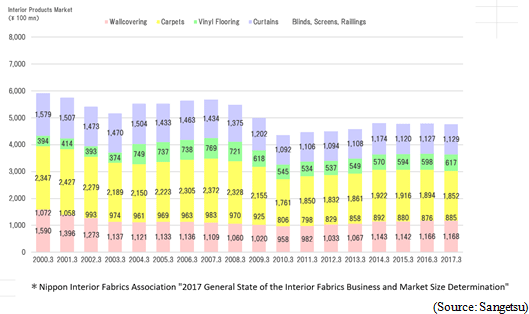 The trends for both Sangetsu's sales and the Japanese interior market have been closely linked to new housing starts. After the Lehman Brother's Shock however, this link has been overcome with Sangetsu's sales reaching consecutive record highs despite the sluggish trends in new housing starts and the weak overall market. 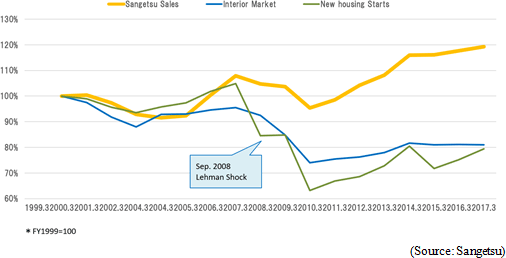 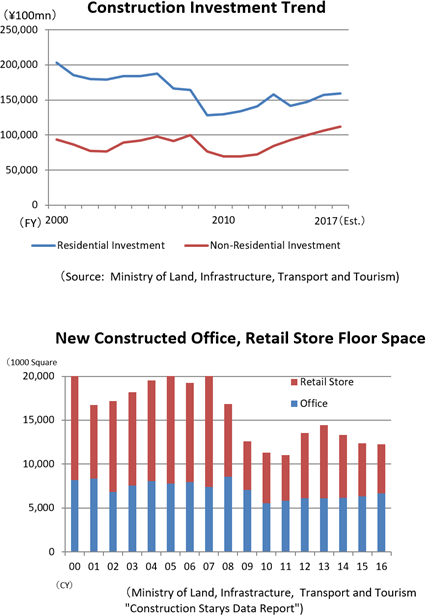 On the other hand, according to "Outlook for Investment in Construction based on a Construction Economy Model" released by Research Institute of Construction and Economy (on Oct. 30, 2017), the year-on-year growth rate of investment in private non-housing construction has been as healthy as 9.3% for fiscal 2014, 5.7% (estimate) for fiscal 2015, and 4.9% (estimate) for fiscal 2016, but is forecasted to become as sluggish as 1.2% (estimate) for fiscal 2017 and minus 0.5% (estimate) for fiscal 2018. The growth rate of the floor area of offices to be constructed is as healthy as 10.3% for fiscal 2016 and 13.7% (estimate) for fiscal 2017, but 0.0% (estimate) for fiscal 2018. That of stores is as sluggish as minus 7.6% for fiscal 2016, minus 10.2% (estimate) for fiscal 2017, and minus 2.0% (estimate) for fiscal 2018. As Tokyo Olympics and Paralympics are scheduled to be held in 2020, the demand for new construction and renewal in the private non-housing market is healthy, but there is a bottleneck due to the shortage of manpower, and there remain uncertainties. According to the Ministry of Land, Infrastructure and Transport, private sector residential investments declined less than private sector non-residential investments and recovered to above the 2000 year level of ¥10 trillion in recent years. At the same time, the Research Institute of Construction and Economy report entitled "Construction Economy Forecasting Model for Construction Investments" released on April 26, 2017 estimates that private sector non-residential construction investments steadily rose by 9.4% and 5.6% year-on-year in fiscal years 2014 and 2015 respectively, but then its speed will be down in fiscal years 2016 and 2017 by 0.6% up and 1.2% down respectively. On a floor space basis, office space is expected to have grown by 12.1% year-on-year while retail store space to have fallen by 8.8% year-on-year in fiscal year 2016, while office space and retail store space both trended sideways at 0.0% in fiscal year 2017. Ahead of the 2020 Tokyo Olympic and Paralympic Games, private sector non-residential construction investments are expected to continue to trend strongly, despite some uncertainties clouding the near term horizon. ◎ Competitors
In addition to Sangetsu, there are eight publicly traded competitors that operate in the interior decorating market.
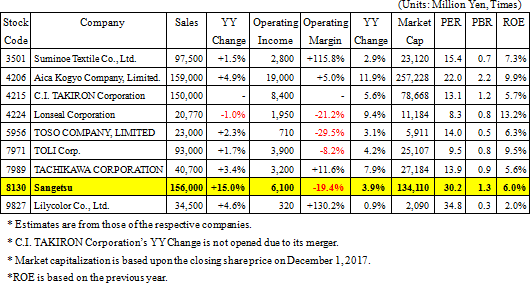 <Business Description>
The main businesses include planning, development, and sales of wallcovering, floor covering, curtains, upholstery and other interior products. Sangetsu boasts of a "fabless operation" and does not maintain any manufacturing facilities, but its capabilities exceed that of typical trading firms, and all of the products it sells are planned, designed and developed in-house. In addition, Sangetsu provides exterior products and lighting fixtures through its subsidiary.
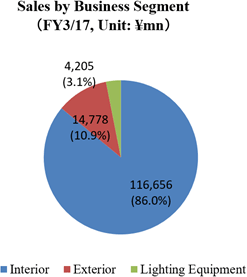 ① "Interior Business"
(FY3/17: Sales and Operating Income of ¥116.656 and ¥7.150 Billion) 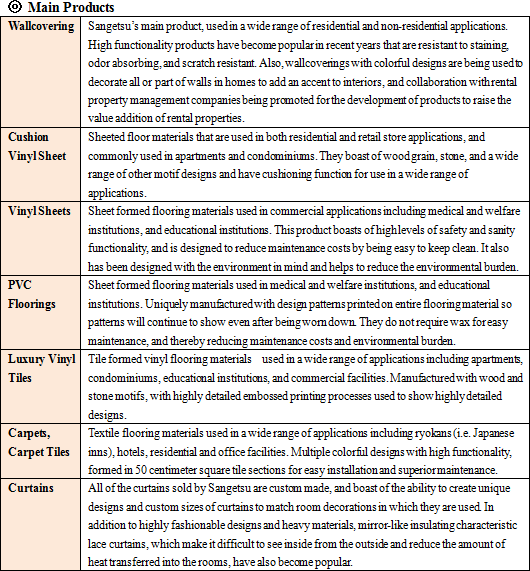 Replacement of existing products is not a simple task. Disposal of products leads to wastes, but the disposal of existing products due to replacement with newly designed products is necessary to maintain the attractiveness of the product catalog and to satisfy customers. Therefore, the ability to maintain a balance between attractiveness and efficiency is highly important and is one of the strengths of Sangetsu. ◎Marketing Structure
In addition to the headquarters located in Nagoya, Sangetsu maintains 8 regional offices and 53 marketing offices throughout Japan, with 9 of these marketing offices also hosting showrooms.
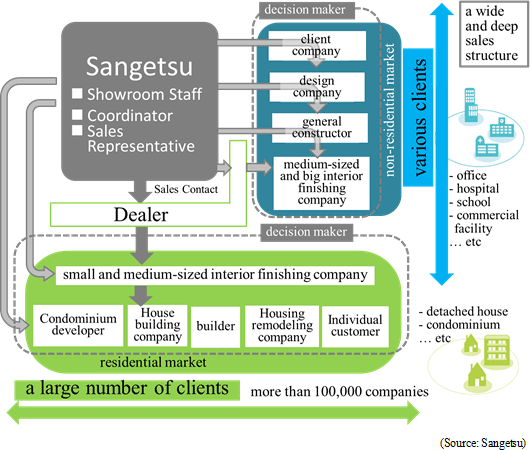 Therefore, Sangetsu conducts public relations and advertising for its products in its product catalog, at its showrooms, and so on. In addition to these "passive" marketing activities, Sangetsu also conducts "proactive" marketing of its products through its corporate marketing division and its 450 marketing staff to provide and gather information and propose products to clients. While the main marketing efforts are conducted through dealers, Sangetsu also conducts direct marketing to customers in the Nagoya and surrounding Chubu area, and the number of its directly accessed customer totals 6,000 in these regions alone. While the number of customers dealt with through dealers is not known, the total number of customers is estimated to amount to several tens of thousands nationwide. ◎Distribution Structure
Sangetsu maintains a network of 13 distribution centers nationwide. Most all products are normally stocked at the Company's distribution centers in Tokyo, Nagoya, Osaka and Fukuoka, with the number of products shipped from these centers surpassing 60,000 per day and the out-of-stock ratio amounting to a low 0.14% (About 70 products) per day.Sangetsu seldom asks their clients for backordering because the out-of-stocks are covered by surrounding distribution centers immediately. Sangetsu's nationwide distribution network makes "Just-in-Time" provision of products to match the interior construction schedules of its clients possible. Products are sourced from a wide range of over 100 supplier companies. ② "Exterior Business"
Sungreen Co., Ltd., which was turned into a subsidiary in 2005, sells doors, fences, terraces and other exterior products within Japan.
(FY3/17 Sales and Operating Income of ¥14.778 Billion and ¥402 Million) ③ "Lighting Business"
Yamada Shomei Lighting Co., Ltd., which was turned into a subsidiary in 2008, sells down lights, z-lights and other general lighting fixtures within Japan.
(FY3/17 Sales and Operating Income of ¥4.205 Billion and ¥ 23 Million) ④ Overseas business
The business strategy set in the mid-term management plan (2017-2019) "PLG 2019" is to conduct consolidated business administration while focusing on the overseas market. Accordingly, this segment was established in the 1st quarter of fiscal year ending Mar. 2018. This business is operated by Koroseal Interior Products Holdings, Inc., which was acquired in Nov. 2016, and Sangetsu (Shanghai), which was founded in Apr. 2016.  <Characteristics and Strengths>
Sangetsu is a pioneer in the realm of "fabless companies" that do not maintain their own manufacturing functions and therefore have lower fixed expense burdens because they do not have to carry facilities for the manufacturing process. Besides, the Company boasts of over 12,000 products, sourced from over 100 suppliers, supplied to several tens of thousands of customers, which diversifies risk in many ways. Moreover, while Sangetsu may be considered as an economically sensitive company as its business and earnings performances are closely linked to trends in the construction market, the Company has never seen losses since its founding.
① Business Model Capable of Yielding Stable Earnings ② "Creating," "Proposing," "Providing"
While the actual manufacturing of products is not conducted in-house, Sangetsu performs the planning, design and development functions internally. The previous generation of Sangetsu management made active investments for "unique designs," one of the three principles of the Company. 25 in-house designers develop new and original versions of products based upon numerous basic designs. The cultivation of designers responsible for various products is done through participation in foreign exhibitions, communication with marketing staff, and discussions with outside design consultants as part of their on-the-job training. Furthermore, Sangetsu maintains a policy of actively taking the perceptions and opinions of younger designers and staff into consideration. Sangetsu also boasts of an overwhelming number of products of about 13,000 that far exceeds the number of products of its competitors. In addition, the Company conducts revisions of its products on a regular basis every 2 to 3 years with more than 30 types of catalogs, which far surpass those of its competitors. The product lineup of Sangetsu is composed of about 12,000 kinds of products, boasting unrivaled variety. As another outstanding characteristic, the company offers about 30 kinds of sample books, which are revised at intervals of 2 or 3 years.
"Creating" 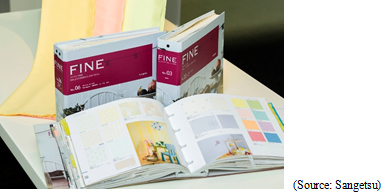 "Proposal based sales marketing"
Nearly one third of all employees or some 450 work in marketing functions at Sangetsu, the largest marketing function within the industry. These marketing staffs are assigned to 61 offices located throughout Japan and conduct proposal-based marketing to clients. Sangetsu also staffs its 9 showrooms with 45 employees. In addition, about 40 interior designers create design boards that combine samples of various products for customers to use when choosing interior products. This high level of proposal-based marketing capability is unmatched within the industry and sets Sangetsu apart from its competitors.
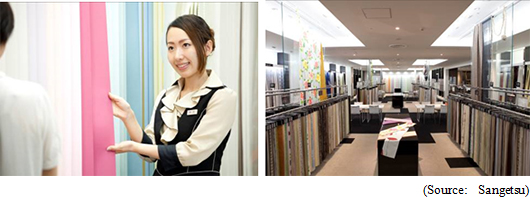 "Distribution system"
As mentioned earlier in this report, Sangetsu normally maintains inventories of all of its products so that they can be provided on a "Just-in-Time" basis using their nationwide distribution network. However, the Company is required to conduct speedy processing techniques as product orders are placed so that loss rates can be limited to avoid the maintenance of excess inventories and reduced efficiencies. Generally, wallcoverings are produced in rolls as long as 50 meters, and Sangetsu cuts these rolls into shorter segments when orders are placed for shipment. The remaining segments of wallcovering are then cut to match other orders to eliminate losses. This type of custom-made cutting technology has been cultivated over the long years of experience in the interior decorating business and is an important factor that differentiates Sangetsu from its competitors.
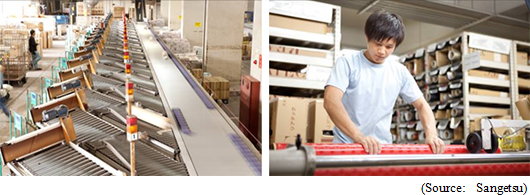 |
| First Half of Fiscal Year March 2018 Earnings Overview |
 Sales grew, but profit declined due to the increase of selling, general and administrative expenses. Sales and profit exceeded the respective initial estimates.
Sales were ¥75.5 billion, up 16.2% year on year. The interior and exterior businesses grew, and the sales of Koroseal, which was acquired in the previous term, and Fairtone, which was reorganized into a subsidiary, contributed. Gross profit rose 20.3% year on year, exceeding the growth rate of sales, and gross profit rate increased 1.1% year on year, but selling, general and administrative expenses augmented 29.7% year on year due to the posting of selling, general and administrative expenses of the above 2 companies, the development of distribution facilities, the preparation for the reconstruction of mission-critical systems, the increases in personnel and distribution costs, the rise in goodwill amortization for new consolidated subsidiaries, etc. Then, operating income dropped 21.5% year on year. Both sales and profit exceeded the respective initial estimates. Profit dropped due to the investment in structural reform and functional enhancement, but the company thinks that its performance of business, including the product development , selling skills, and distribution function, has improved steadily. In addition, through overseas business expansion, the collaboration among Japan, the U.S., and China in product development and procurement is progressing. 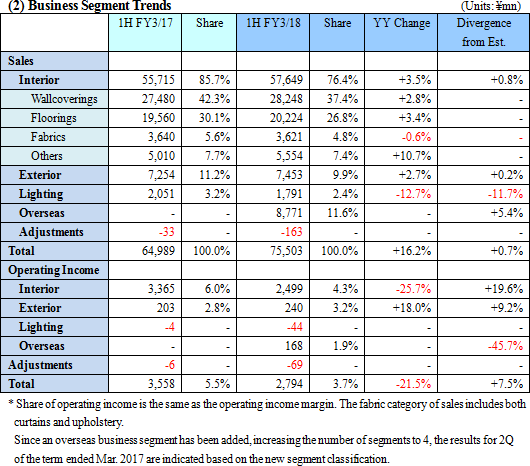 ① Interior Business
Sales grew, while profit dropped.<Wallcovering Materials> Sales increased. The sales promotion with "FAITH," a book of certified fireproof wallcovering samples, published in Feb. 2017, targeting the non-housing field paid off, and the products were adopted by hotels, accommodation facilities, etc. The company also held "Sangetsu Wallpaper Design Awards 2017," attracting many applicants, and announced the winning designs in Aug. Like this, Sangetsu concentrated on brand development to perform "Joy of Design." <Flooring Materials> Sales increased. Sangetsu published a sample book of carpets in Jun. 2017, and a sample book of floor tiles in Sep. and then engaged in active PR activities targeting design offices and coordinators through exhibitions, etc. The company received the Good Design Award 2017, for "Flotex," a high-tech textile which has ultrahigh-density pile structure, and vinyl flooring properties such as strong, easy cleaning.. Then, the company made efforts to develop and enrich new products. <Fabric Materials> Sales declined. In Jul. 2017, Sangetsu published "STRINGS," a comprehensive sample book selecting good raw materials and high-quality products, and "Simple Order," a fabric collection of easy order system which composed of the same price fabrics.. The company held a product rollout at 30 places nationwide, to popularize products in the market. The performance of curtains for contract facilities and upholsteries, which were promoted with the dedicated marketing system, was healthy. <Others> Sales grew. The performance of Fairtone Co., Ltd, which operates the installation system and the fees for installation work are included. ② Exterior Business
Sales and profit increased.As the competition with other companies became fierce, Sangetsu redeveloped the marketing management system and continued the improvement of installation capability. As the demand for "comfort" and "convenience" grew, the exterior products for facades for designing the entire appearance of an entrance and items, such as delivery lockers, contributed to sales. Business performance was healthy, as the company received large-scale orders in the Kanto region, expanded transactions with existing clients, and increased sales from installation work. ③ Lighting Business
Sales dropped, and loss augmented.In the contract market, which is the target of the company's intensive strategy, Sangetsu conducted a broad range of marketing activities, including the collaborative product development with leading design offices and sales promotion of road lamps. However, it struggled amid the fierce price-cutting competition. ④ Overseas Business
Koroseal, which targets the North American market, carried out marketing activities to meet the new needs in the market, by selling products that have a traditional Japanese taste, such as Japanese paper, and "Reatec," an adhesive-mounted decorative film. Sales grew 5.1% from the previous year, in which Koroseal had not yet been acquired, and the marketing system in North America was improved and fortified, but sales growth rate was sluggish.Sangetsu (Shanghai), which targets the Chinese market, is steadily cultivating the market, as the local wallcovering sample book attracted customers and the number of orders has been increased such as medical facilities. 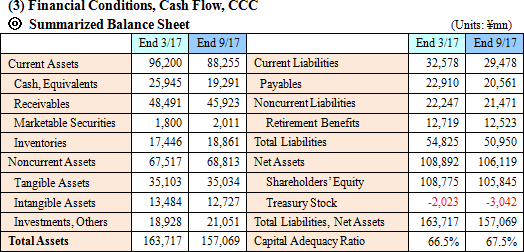  The deficit of financing CF augmented due to the increase in purchase of treasury shares. The cash position degraded. The total amount, including time deposits whose deposit term exceeds 3 months and highly liquid investment securities, declined from 29.7 billion yen at the end of Mar. 2017 to 24.3 billion yen at the end of Sep. 2017. The amount of 25 to 30 billion yen is considered appropriate from the viewpoint of stability, and it has decreased to around the lower limit.  (4) Major Activities
1. Establishment, integration, and dismantlement of distribution facilitiesIn May 2017, Sangetsu started operating Chubu Logistics Center (LC) II in Inazawa City, Aichi Prefecture. The operation of the delivery system based on this center and the adjoining Chubu LC I began. In August, the stocks of the floor tile and Reatec, which is one of major products, were transferred from the manufacturer's warehouse to Chubu LC III. In Oct., the stocks of products were temporarily transferred from the manufacturer to a warehouse in Shinagawa, and curtain fabric was directly brought to the sewing factory in Namegata City, Ibaraki Prefecture, to streamline distribution. As for the distribution system in the Tokyo Metropolitan Area, which is the primary issue to be solved, the company plans to integrate two facilities in Shinagawa and Katsushima into a new distribution center in Heiwajima. 2. Product development The company published 8 sample books, including "2017-2019 Fine" for wallcovering materials, "2017-2019 Roll Carpets" for flooring materials, and "STRINGS 2017-2019" for curtains. In addition, the company received the Good Design Award 2017 for wallcovering and flooring materials. 3. Strengthening of quality management Sangetsu established a product testing laboratory in Chubu LC II in Inazawa City. By installing a variety of testing equipment and hiring 4 operators, the company developed a system for evaluating new technologies by conducting acceptance inspection, reproducing phenomena about which customers complained, grasping the effects of countermeasures, and checking the stability and continuity in case manufacturers release new products. The operation of a necessary and sufficient system for quality control as a fabless manufacturer has been started. 4. Restructuring of the selling system Sangetsu is developing a strategic marketing system for each layer of the value chain. For improving flexibility in each market, the company established a residential marketing department, to strengthen the marketing system for house manufacturers and builders. Inside the corporation-targeted marketing department, the company established Eastern Japan Reatec Section and Western Japan Reatec Section, which handle "Reatec," a self-adhesive PVC decorative film whose profit rate is relatively high. Likewise, the company strengthened the system for selling products with high added value, which requires expertise and marketing capability, by increasing the staff of the upholstery division, which handles upholsteries. 5. Overseas business (Koroseal) It locally published 7,000 Reatec sample books for the U.S. to develop a system for selling "Reatec" in the U.S. for the purpose of enhancing the business synergy with the company. The strong effect on profit is expected. In addition, it released traditional Japanese wallcovering made of woven fabric, foil, paper textile, etc., which are attracting attention also in the U.S. Sangetsu(Shanghai) The number of staff members was increased to establish an 8-member selling system. After a local sample book introducing functional products was published, medical facilities, etc. adopted the products of Sangetsu, and sales in China are steadily growing. The cooperation in product procurement began in Japan, the U.S., and China. 6. Acquisition of treasury shares During the 2nd quarter, the company acquired 1.69 million treasury shares worth ¥3.3 billion, and retired 1.07 million shares, in accordance with the policy of retiring acquired shares swiftly. The number of outstanding shares is 67 million, down about 13 million (16%) from 4 years ago. |
| Fiscal Year March 2018 Earnings Estimates |
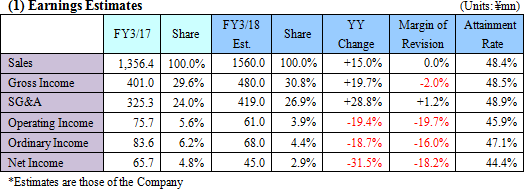 Profit has been revised downwardly.
The full-year forecast for profit has been revised downwardly. Sales are estimated to be ¥156 billion, up 15.0% year on year. Domestic and overseas sales are projected to be nearly equal to the respective initial estimates. The number of houses to be newly built is forecasted to decline slightly, but the company will enhance marketing activities for wallcovering and flooring materials in the non-housing field, and aim to increase sales by implementing new projects for sample books and releasing new products. The estimated sales growth of ¥20 billion will come from the sales increase of over ¥3.5 billion in the interior business, seeing the inclusion of Fairtone Co., Ltd. in the consolidation scope, and the sales increase of ¥17 billion in the overseas business, witnessing the inclusion of Koroseal in the consolidated profit-and-loss statement. Operating income is estimated to be ¥6.1 billion, down 19.4% year on year and down ¥1.5 billion or 19.7% from the initial estimate. The gross profit rates of the interior business and Koroseal have been revised. The selling, general and administrative expenses of the interior business is forecasted to be ¥240 million smaller than the initial estimate, while the selling, general and administrative expenses of the overseas business is projected to be ¥280 million larger than the initial estimate. There is no change to the estimated dividend. The annual dividend is to be ¥55/share. The estimated payout ratio is 81.0%. 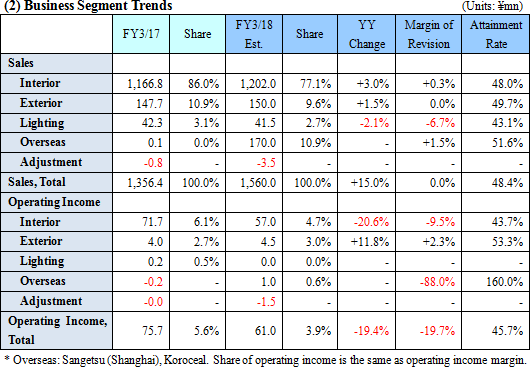 |
| Interview with President Yasuda |
|
Q: "What is your evaluation on the recent circumstances?"
A: "The enhancement of product development capability and the improvement of the marketing system are paying off steadily."
Currently, we are brushing up our product competitiveness and marketing capability.As for product development, we produced new sample books reflecting our new price system, including "reasonable price setting while keeping a classy taste" and "one price," and enriched our product lineup, including the sample book for non-housing wallcovering, which is a new series of our products, from the second half of the previous term to the first half of the current term. In addition, "Black Board," a wallcovering on which you can draw with chalk like a blackboard, and "FLOTEX," a new fiber flooring material that has the characteristics of a carpet and a hard flooring material together, received the Good Design Award 2017. We were able to develop products that could improve our added value and brand competitiveness. The improvement of the marketing system is also progressing. In order to cultivate the non-housing market further, we established some sections for respective kinds of clients, including general contractors and architectural design offices, inside the corporation-targeted marketing department, established Reatec Sections, which handle the highly profitable wallcovering material "Reatec," and increased marketing staff members of the upholstery division. These measures have been reflected in the results. Since fiscal 2013, which witnessed the rush demand before the consumption tax hike, the nonconsolidated sales growth rate of our company (the existing interior business) has been as low as 0.2% for fiscal year ended Mar. 2015, 1.6% for fiscal year ended Mar. 2016, and 1.0% for fiscal year ended Mar. 2017, but it is as healthy as 2.5% for the first half of the current term, which is higher than those of competitors as a whole, and our share is expanding. It can be said that the enhancement of product development capability and the improvement of the marketing system are steadily paying off. 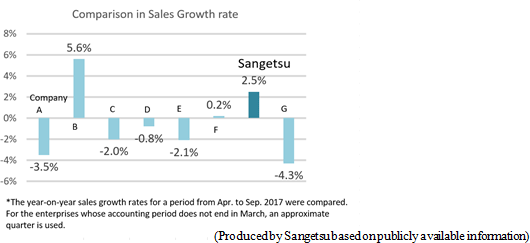 Q: "How are your activities for inducing the synergetic effect with Koroseal after M&A?"
A: "As our communication has been deepened and the details of their business have become clear, our company is giving various proposals. Synergetic effects are being exerted little by little."
We attend the bimonthly board meeting of Koroseal, and hold a television conference involving the responsible person of each section when necessary, to deepen our communication. At first, we only received reports, but as the details of their business became clear, we joined their discussions, giving various proposals. For products, the staff of Koroseal visit Japan, to actually see our products, and started selling traditional Japanese products, including foil and paper textile. Like this, synergy is being exerted gradually. At the beginning of next year, our corporate group's public relations magazine will be published. As the system covering the three regions: Japan, the U.S., and China has been completed, we will publish a PR magazine in Japanese and English twice a year, to send various messages and facilitate the understanding inside our corporate group. Q: "Please tell us about your CSR activities."
A: "As the CSR activities for the entire supply chain are important, we produced the CSR guidelines for business partners of Sangetsu. We pay a lot of attention to CSR activities unique to Sangetsu, too."
With the aim of achieving sustainable growth, we uphold the policies regarding ESG and CSR in our mid-term management plan, but the CSR activities in the entire supply chain are important, and it is indispensable to cement our cooperation and collaboration with business partners.Then, in Oct. 2017, we produced the "CSR guidelines for the business partners of Sangetsu" to clearly state the requests to business partners. These guidelines are composed of "A. Observance of laws, regulations, and social norms; and fair, equitable corporate activities," "B. Promotion of sound business operation," "C. Provision of excellent products and services," "D. Care for global environment," "E. Active promotion of social contribution and eradication of antisocial forces," "F. Care for human rights, labor safety and health," "G. Information disclosure and promotion of communication," and "H. Check and monitoring of the situations of confidentiality and information security." There were enacted with reference to the Global Compact of the United Nations, the GRI Guidelines, etc. As for CSR and ESG, I think that "Sangetsu's unique features" are important. We engage in various activities, among which "the support for the refurbishment of welfare facilities for pupils" can be said to be a CSR activity that characterizes our company. By utilizing our interior materials (wallcovering, flooring materials, curtains, and upholsteries) and installation skills, we support the refurbishment of the interior spaces of welfare facilities for children throughout Japan, so that more people will be able to enjoy comfortable living space. In cooperation with National Council of Orphanages, we have refurbished the interior spaces of 21 facilities around Japan till March 2017. The participating employees feel pleasure to see children of orphanages rejoicing, and this activity provides non-marketing staff, who do not usually visit the sites where our products are installed, with an opportunity to deepen their understanding of our jobs. |
| Conclusions |
|
However, its share price remains low, compared with the market trend and competitors'. We would like to pay attention to how much the company will further earn sales and profit in the third and fourth quarters. 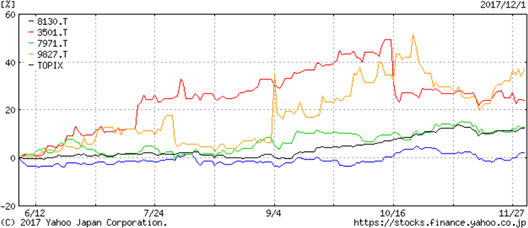 *Relative share prices over the past 6 months. Blue: Sangetsu, Red: Suminoe Textile, Green: TOLI, Yellow: Lilycolor, Black: TOPIX
|
| <Reference 1:Medium Term Business Plan "PLG 2019" (2017-2019) Overview> |
|
◎Vision
Based upon the "Corporate Creed: Integrity" and "Brand Philosophy: Joy of Design", Sangetsu has created its Medium Term Business Plan "PLG 2019" with the goal of establishing strong roots within both the Japanese and overseas markets by leveraging the Group's "diversified product lineup and highly specialized knowledge"."P" stands for personal and reflects the highly professional employees that helps it to link to people outside of the Company. "L" stands for local and refers to the strong positioning in local markets. "G" stands for global and represents Sangetsu's global lineup of products and designs. 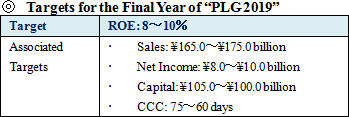  ◎Themes
As a basic policy, Sangetsu has identified the following measures as part of its strategy of "strengthening the function and expanding geographic sales of the interior materials business (planning, procurement, logistics, sales)".
(1) Business Strategy for Growth
① Realizing Stable Growth in Earnings through Expansion and Strengthening of the Value Chain Activities Realm in Japan as a Fundamental and Stable Source of Revenues
Sangetsu will promote "development and procurement of materials and raw materials through alliances with superior suppliers within and outside of Japan", "strengthen interior coordinator proposal and installation capability", "fortify alliances and cooperation with dealers" and "conduct reviews of internal sales structure".
② Strengthen Activities in Overseas Markets with High Growth Potential, Fortify Product Lineup and Functionality to Promote Geographic Expansion
Local logistic and sales structures will be strengthened in important markets including North America, Asia and others.
③ Create a Global Product Planning, Procurement Structure to Promote Global Designs, Cultivate Global Product
Sangetsu will strengthen cooperation with local facilities in Japan, United States and China for the implementation of "cooperation between Sangetsu globally and superior overseas product manufacturers" and "efforts to promote joint marketing of products and deployment of European and Japanese designs".
④ Strengthen Consolidated Management Structure to Pursue Comprehensive Synergies, Integrated Management of Affiliates Responsible for Special Markets, Functions and Geographic Regions
A management structure system will be introduced to maximize business synergies and conduct clearly controlled earnings management, and to act as a surveillance support structure for the overall Group.A consolidated management division will be newly established with authority to oversee the entire Group. In addition, regularly scheduled monitoring and communications will be introduced to increase the overall effectiveness of the Group. ⑤ Business Format Conversion Trials to be Conducted with a View to the New Medium Term Business Plan
In order to pursue synergies and leverage business resources and the characteristics of each Group company, Sangetsu will conduct trials and promote business format conversion.
(2) Strengthen Human Resources
In order to cultivate real professionals, all of the Sangetsu Group companies will implement measures to 1) cultivate professional human resources, 2) conduct strict adherence to performance, 3) promote diversity, 4) reform work styles and 5) maintain a healthy management structure.
(3) Strengthen the Earnings Management Structure
① Strict Control, Reduction of Sales, General and Administrative Expenses
A chief cost controller will be appointed, and sales, general and administrative expense control methodologies will be facilitated. Also, the total number of staff of the parent company Sangetsu will be reduced.
② CCC Management Will be Introduced for All Group Companies
Targets for return on equity and CCC management through Dupont analysis on a consolidated basis will be promoted.
③ Sangetsu to Clearly Define and Promote Management Benchmarks for Each Business, Company
Targets for sales and gross income by employee will be established for each of the Group companies.
(4) ESG/CSR Policies
① E: Environment
② S: Society
③ G: Governance
(5) Capital Policy
① Financial Policy for Improvement of Capital Efficiency
Sangetsu will continue to conduct share buybacks and stable increases in dividend payments with a goal of reducing its net worth to between ¥100.0 and ¥105.0 billion (¥108.8 billion as of FY3/17) with a view to conditions within the capital markets.
② Shareholder Return Policy of the Medium Term Business Plan
 |
| <Reference 2: Regarding Corporate Governance> |
 ◎ Corporate Governance Report
Last modified: March 28, 2017.<Basic policy> Our corporate creed is "Integrity," and we aim to foster good relationships with all stakeholders to improve our corporate value and grow stably on a long-term basis. To attain these goals, we consider that it is essential to improve our corporate governance based on the transparency, swiftness, and efficiency of business administration. In June 2015, our company was reorganized from a company with the board of auditors to a company with an audit committee, with the aim of animating discussions from the viewpoint of shareholders by strengthening the auditing and supervising functions of the board of directors and increasing the ratio of outside directors. Under this governance system, we will make efforts to further improve our corporate value. <Reasons for Non-compliance with the Principles of the Corporate Governance Code (Excerpts)> The company implements each principle of the Corporate Governance Code. 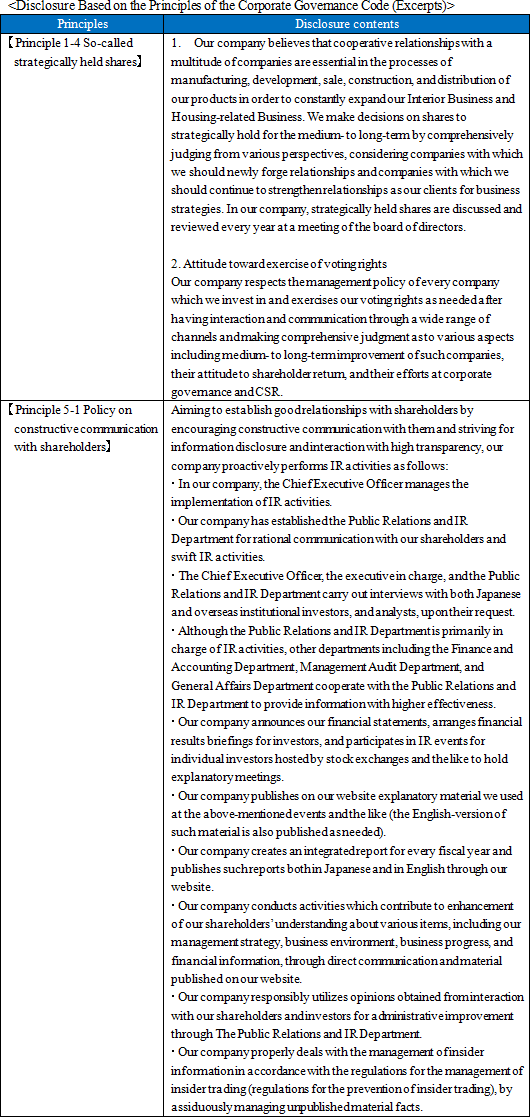 Disclaimer
This report is intended solely for information purposes, and is not intended as a solicitation to invest in the shares of this company. The information and opinions contained within this report are based on data made publicly available by the Company, and comes from sources that we judge to be reliable. However we cannot guarantee the accuracy or completeness of the data. This report is not a guarantee of the accuracy, completeness or validity of said information and or opinions, nor do we bear any responsibility for the same. All rights pertaining to this report belong to Investment Bridge Co., Ltd., which may change the contents thereof at any time without prior notice. All investment decisions are the responsibility of the individual and should be made only after proper consideration.Copyright(C) 2018 Investment Bridge Co., Ltd. All Rights Reserved. |

